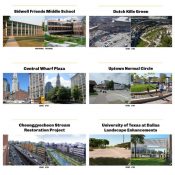Author: Matt Alcide
LandscapePerformance.org: A Resource You Should Be Using
The Landscape Architecture Foundation’s Landscape Performance Series received the 2015 Award of Excellence in Communications as part of the American Society of Landscape Architects (ASLA) Professional Awards. While the initiative has been around for a few years, the new LandscapePerformance.org website was launched only about a year ago. Here, we review this new website, which is a total revamp of the Landscape Performance Series, with the resources repackaged in a clean, elegant design.
The website focuses entirely on landscape performance, which LAF defines as “a measure of the effectiveness with which landscape solutions fulfill their intended purpose and contribute to sustainability.” Landscape performance includes environmental, social, and economic impacts like flood protection, carbon sequestration, educational value, and operations and maintenance savings. The Landscape Performance News blog and Watch List showcase interesting happenings from new research on the benefits of landscape to reflections on the promise of smart city technologies.
The heart of Landscape Performance.org is the four main resources that LAF compiles and produces. The Case Study Briefs of high-performing landscape projects now number over 100. They include measurable environmental, economic, and social benefits and cover a wide range of project types, sizes, and locations.
The Fast Facts Library has some 120 summaries of benefits of landscape from published research. The Benefits Toolkit contains 23 online tools and calculators to estimate performance. And the new Collections are the above content compiled around different themes, some by guest curators who share their own unique insights.
The streamlined design, use of images, and new filtering capabilities make it easy to use. LAF has added tags like “Active Living” and “Complete Streets” as an alternate way to browse the content. Another smart addition is the Related Content column to help users discover more relevant items. And for the truly research-minded, LAF has made the entire database behind their Case Study Briefs downloadable, so that anyone can analyze the collection to see whether certain benefits relate to project type, size, budget, etc.
LAF says that you can use the Landscape Performance Series resources to help you:
- Find precedents, show value, and advocate for sustainable landscape solutions
- Explore metrics and methods to quantify environmental, social, and economic benefits
- Earn professional development hours (PDHs) by attending a presentation or webinar
- Browse and share teaching materials to integrate landscape performance into design curricula
- Stay current on landscape performance news and trends
We think the new website is an excellent resource for all of the above.
What are your thoughts of the new LandscapePerformance.org? Use the comments section to share how you are using the website, what resources are most useful, and what you’d like to see more of.
3 Ways to Sustain Nature in Built Environment
Sustaining Nature and Natural Processes in Ultra-Urban Environments [LAF + DeepRoot Roundtable]
1. Bringing standards of care to ROW
2. Cities and forests: more alike than not
3. Get out of your silo!
- 1
- 2



